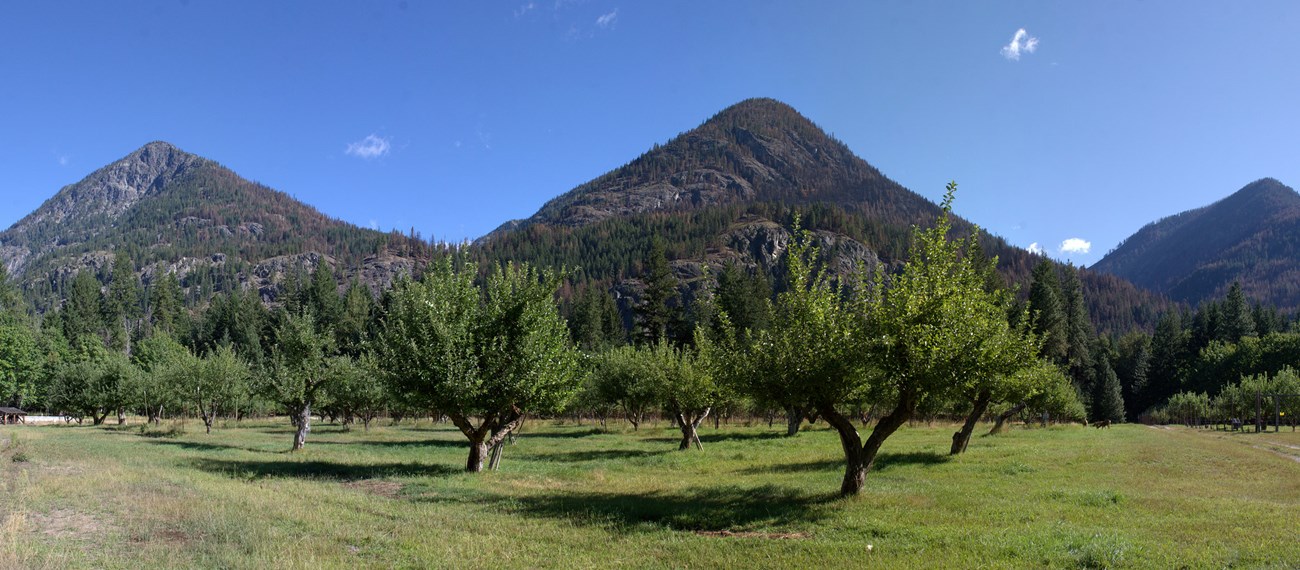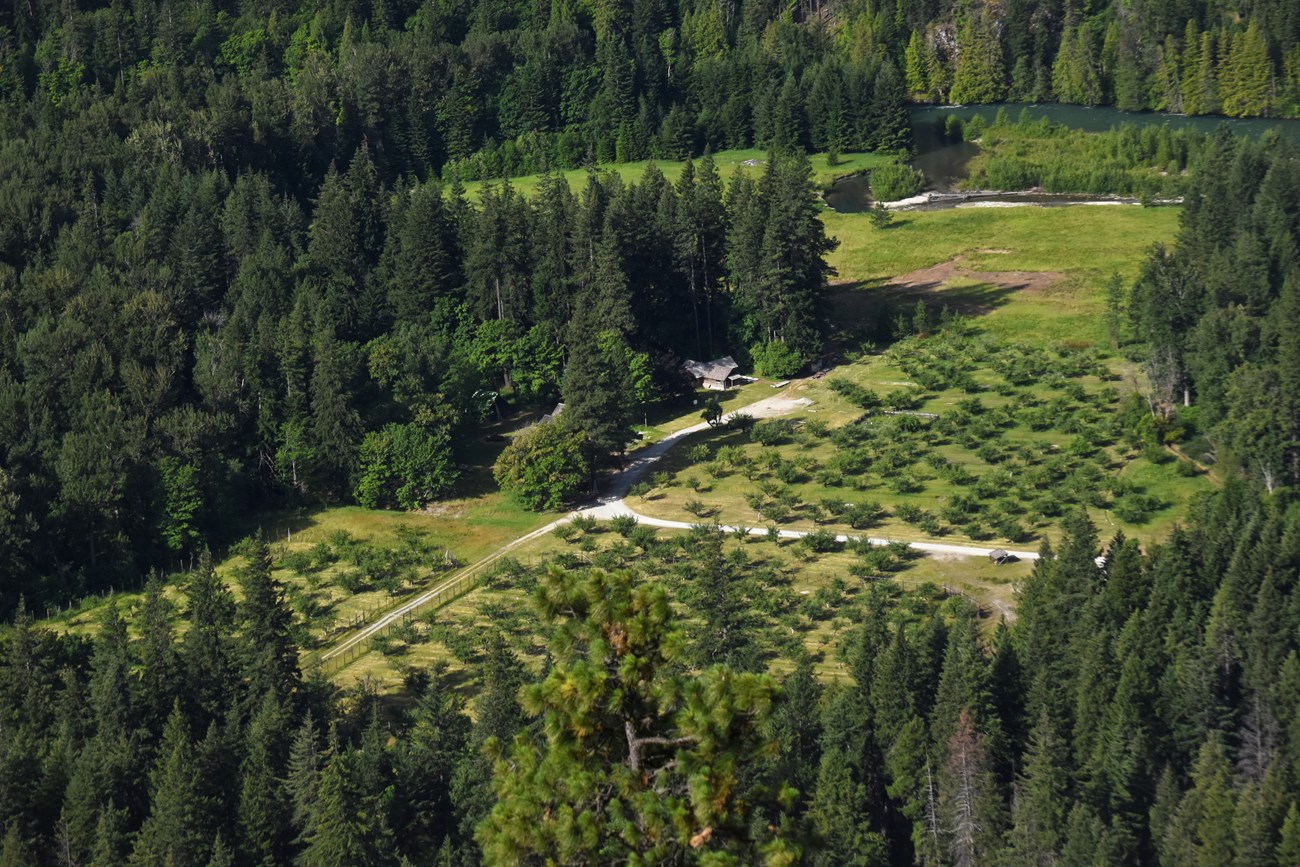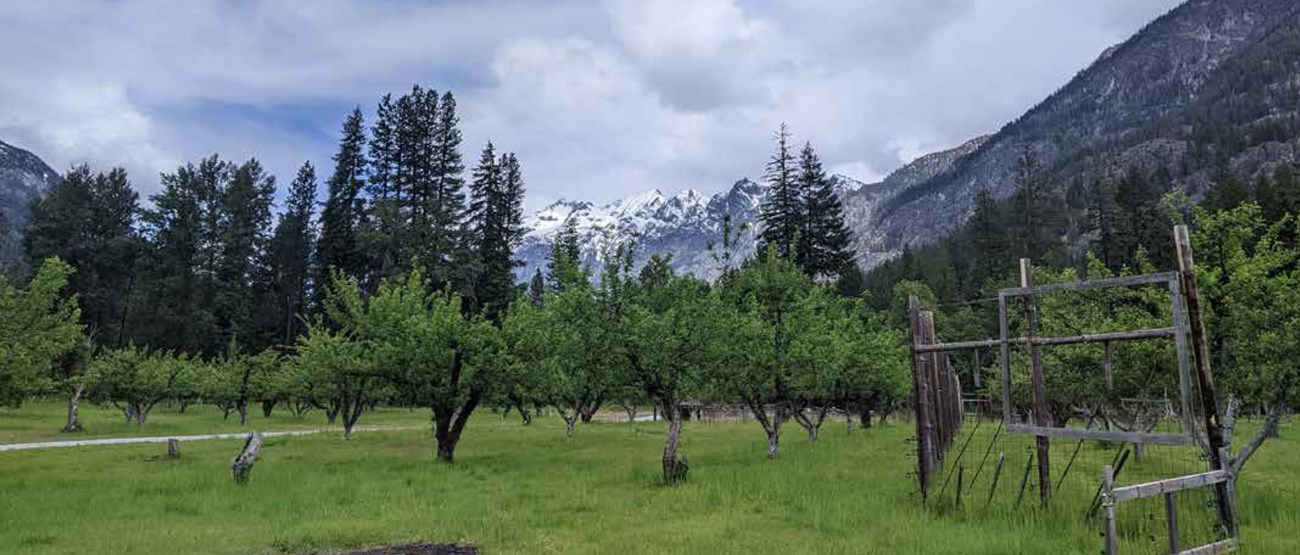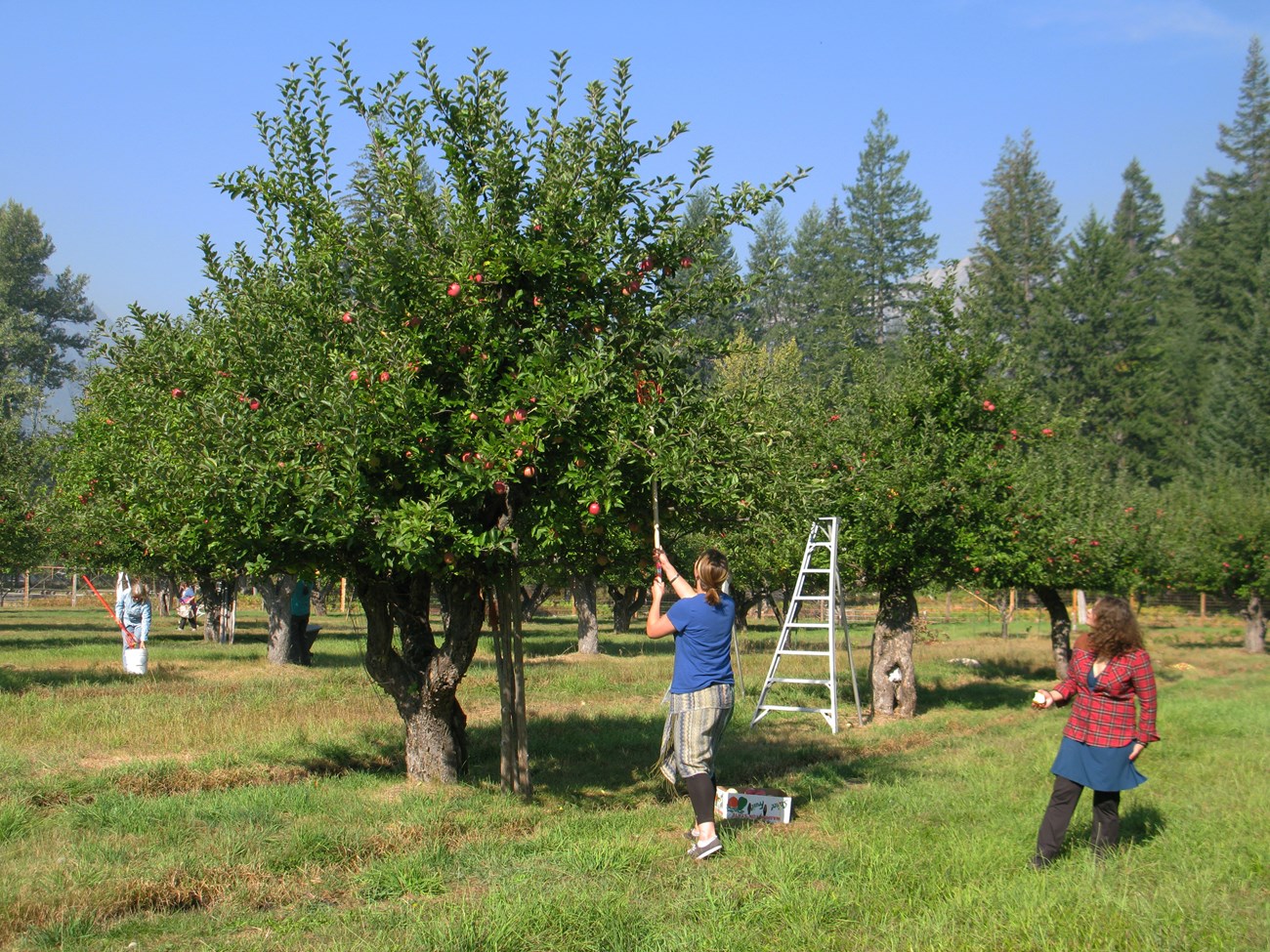Last updated: April 5, 2024
Article
Buckner Orchard History and Care
The Buckner Orchard represents a time period of revolutionary transformation in the commercial apple market. It continues to be an important repository of the heirloom Common Delicious apple variety.
Introducing the Buckner Orchard
At nearly ten acres, the apple orchard is a prominent landscape feature of the Buckner Homestead Historic District in North Cascades National Park Service Complex. The Buckner family started planting their apple orchard in 1912. By the time that the last trees were added by the family in 1924, the orchard covered nearly 50 acres. As the Buckner family developed their homestead, the property became a focus of community in the Stehekin Valley. Today, the site and its orchard continue to be a place of personal histories and annual routines, inviting people to gather for the fall harvest and cider-making much as they did when the Buckner family lived here.
The National Park Service published a Cultural Landscape Report for the Buckner Homestead Historic District in 2022, documenting the history and management of the landscape over time and serving as a guide to the orchard's preservation into the future.
Landscape History
In the spring of 1911, William and May Buckner, along with their three children, moved to the Stehekin Valley of Central Washington. William’s brother had been drawn to the area over a decade earlier by its mining opportunities, and now William was interested in investing in property.
The Buckners purchased land from William Buzzard along a horseshoe bend in the Stehekin River, located upriver from the head of Lake Chelan. In 1889, Buzzard had claimed the land for a cabin and home site and harvested timber on the property. When the Buckners arrived, they found that tree stumps covered much of their new property, aside from about an acre that was cleared for a garden. They spent the first summer removing stumps to prepare the ground for an orchard.
They also spent several months digging irrigation ditches, starting the system which would divert water to the property from nearby Rainbow Creek. There are several horse-drawn plowing implements remaining on the site today, evidence that the cultivated part of the ranch was most likely plowed. The plows were used regularly to make the rills, which are the irrigation ditches that run alongside the rows of trees. There are also some old horse-drawn sleds, known as stone boats, which were needed to move rocks after leveling the ground with the horse drawn earth-moving tools called "Fresno scrapers."
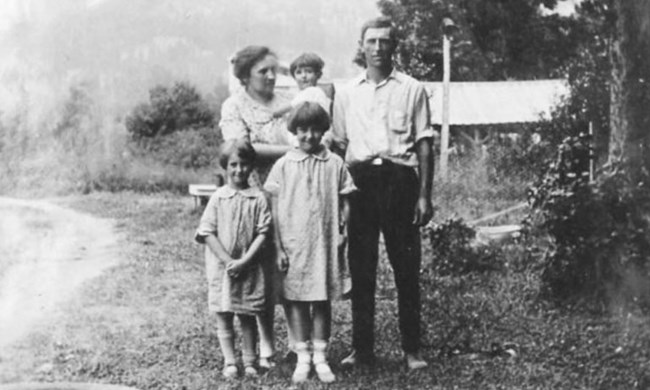
NPS / North Cascades National Park
The next spring, William Buckner bought young fruit trees from the Columbia & Okanogan Nursery in Wenatchee, and the Buckners planted about 20 acres of trees southwest of their cabin along the Stehekin River. During the years that the Buckner family lived here, they continued to develop the landscape.
It was a relatively isolated homestead, surrounded by rugged mountains and dense forest that contributed to a sense of enclosure. Yet by 1910, the population of Stehekin was growing, supported by tourism, logging, mining, subsistence farming, and the arrival of the U.S. Forest Service. The Buckners added cabins for apple pickers and family members, a smokehouse, a barn, a swimming pool, and ornamental gardens. Before long, the Buckner Homestead had become a popular community gathering place, known for both the apple crop and the family hospitality.
William and May lived in the Buzzard Cabin seasonally until 1924, when they returned to California. Several years later, the property was transferred to William’s son Harry. In 1915, Harry had become the first year-round resident at Buckner Homestead when he decided to spend the winter. Harry and Olive married in 1917, and they lived at the Buckner homestead and carried on the orchard work along with their three daughters: Irene, Harriet “Hobbie,” and Elizabeth “Bucky.” The homestead and orchards continued to change as the years passed, and the family sold the remainder of the property to the NPS in 1970.
In 1971, NPS employee Phil Garfoot moved in the Buckner residence with his wife, Wendy, and their family, and they continued to maintain the property and rehabilitate the orchard. The NPS initiated orchard and fruit tree stabilization efforts in the 1980s, but attempts were largely unsuccessful due to inadequate water and pruning and harsh winter storms.
In 1995, following the continued loss of orchard trees, Laurie Thompson arrived as a seasonal orchardist. In addition to providing skilled pruning and consistent maintenance, Thompson participated in wildlife management planning and made repairs to the irrigation system. Most of the replacement orchard trees, 65 total, were planted in 1996. Most of the plantings incorporated soil that was swapped from the pasture to deter any problems of planting into old orchard soil. All have been grafted with the original variety.
Additionally, the NPS caged individual trees to protect them from deer, stripped apples annually for bear protection, and wrapped trunks and limbs with rodent guards. Many of the new trees continue to thrive, growing alongside the original apple trees that the Buckner family planted.
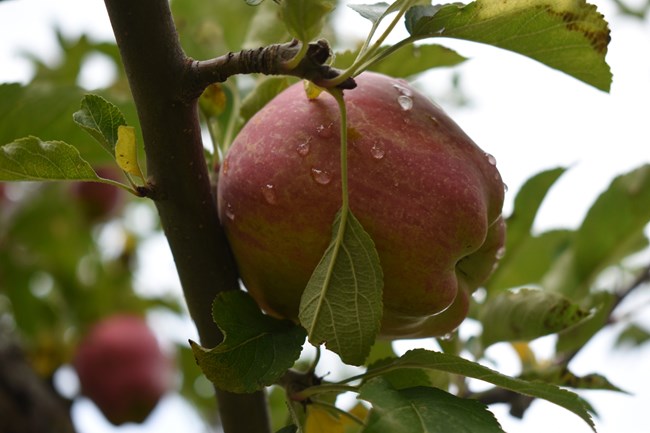
NPS
Varieties
The Buckner Orchard contains the Common Delicious apple, a strain that is no longer grown commercially. First called “Hawkeye,” this variety reportedly earned the name “Delicious” at a fruit show before becoming popular in the 1920s. The Stark Brothers Nursery in Missouri purchased the rights to the variety, sent trees to orchardists around the country, and experimented with strain selection to deepen the color of the peel, leading to the creation of the popular Red Delicious.
The Buckner Orchard represents a time period of revolutionary transformation in the commercial apple market, before the development and spread of the Delicious apple variety by the Stark Brothers. By the 1980s, one of every two apple trees grown in the United States was a Red Delicious. The orchard is an important repository of the heirloom Common Delicious apple variety.
The Buckners also grew Rome Beauty, Jonathan, and Winesap apple varieties. Although they originally comprised just one-fifth of the total number of trees in the orchard, the Rome Beauty trees have proved to be resilient over the years. Rome Beauty trees are good pollinators, and their fragrant apples were once popular desert apples in Pullman railroad cars.
Orchard Care: A Part of Life in Stehekin
Through many years, caring for the Buckner Orchard has become interconnected with daily life in the Stehekin Valley. Today, NPS staff and volunteers prune, harvest, and maintain the orchard, continuing the seasonal routines of the Buckner family.
Buckner Orchard Care: Past and Present
What does orchard maintenance look like at Buckner Orchard? We compare apple tree care during the Buckner family ownership and today.
|
Buckner Family Era |
NPS |
|---|---|
|
At an unknown date, the Buckners constructed a wooden fence, about a mile in length, to protect the trees. It may have been more to keep their own animals in than to keep out wildlife. It would have done nothing to keep out deer and bears. Bears were regularly killed and hauled off. This fence is no longer standing. |
In 2006, the NPS fenced a portion of the orchard with solar-charged electric wires to protect the trees from damage by animals. Elk had not been a threat to the orchard until 2005. A fence with an upgraded gate design was installed in 2010. It allows deer to jump into the orchard to eat the excess fruit, while keeping out the bears and elk that damage the trees. |
|
Buckner Family Era |
NPS |
|---|---|
|
The Buckner orchard represents a style of pruning fruit trees typical during the pre-World War II era. Trees were pruned into a low-headed (short trunk), open bowl canopy with three to five scaffold limbs, which allowed more light to enter the interior canopy and kept the branches closer to the ground. |
Today, pruning and shaping continues to follow this form, particularly after new trees are planted. Most of the pruning occurs in later winter or early spring, depending on the snow and temperatures. |
|
Buckner Family Era |
NPS |
|---|---|
|
After the Buckners picked apples in the fall, they turned their cows and horses into the orchard to graze. They also kept chickens in a large, movable wire enclosure which they moved daily to a new position in the orchard. |
Today, NPS staff apply soil amendments within the fruit tree driplines. This primarily occurs in November or late fall, and occasionally in spring. They also use foliar feeding (a technique of applying liquid fertilizer directly to leaves) to add micronutrients like zinc and boron. |
|
Buckner Family Era |
NPS |
|---|---|
|
The Buckner sisters participated in haymaking. Harry planted alfalfa between the rows of apple trees, to feed the cows for the winter and to return nitrogen to the soil for the trees. They cut hay twice a year, dried, and raked. |
The NPS now mows the orchard floor at least twice a year, and not all at once. Thompson mows in rotation to allow strips or patches of grass, clover, or other groundcover to mature and support beneficial insects. Ditches are mowed more frequently to help water reach the ditches. |
|
Buckner Family Era |
NPS |
|---|---|
|
Historically, the orchard was marked by an elaborate network of irrigation ditches, which brought water from Rainbow Creek. The same system supplied water for laundry, other domestic uses, and power. |
Water does not flow continuously to the trees. Ideally the roots of the trees are able to dry out somewhat, and they can get water every week or two. Because of soil difference and the presence of black rot, the Jonathans are only watered every three weeks. The NPS replowed some of the irrigation ditches to reestablish their functionality, and other components of the irrigation system were also repaired or replaced. The system still operates as it did when the Buckners lived here. Within the orchard, each row of trees has a ditch on either side to deliver water to the trees. |
|
Buckner Family Era |
NPS |
|---|---|
|
Beginning around mid-June and continuing through the summer months, thinning apple trees was a major chore for the Buckner sisters. In The Stehekin We Remember, they reflect that while it wasn’t a favorite task, climbing the orchard ladders did give them an opportunity to do something they considered to be more interesting: keeping on eye on the local boy scout swimming hole.
|
Thinning is an important activity for NPS staff and volunteers. Pinching the blossoms in the spring gives a head start to the massive task of fruit thinning, which continues throughout the summer months and helps to reduce fruit load. This decreases the harvesting effort later in the season. |
|
Buckner Family Era |
NPS |
|---|---|
|
The Buckners began the apple harvest the first week in October, starting with the Jonathan apples, then Common Delicious, then Romes, and finally the Winesaps. In addition to the three Buckner sisters (Bucky, Hobbie, and Irene), some residents of the valley helped with the picking and packing while their mother, Olive, sorted apples. |
While the property no longer operates as a farmstead or commercial orchard, the fall apple harvest remains a significant community event, organized in partnership with the Buckner Homestead Heritage Foundation. The community gathering, harvesting, and cider-making demonstrate how the homestead continues to be a significant place for the Stehekin community. |
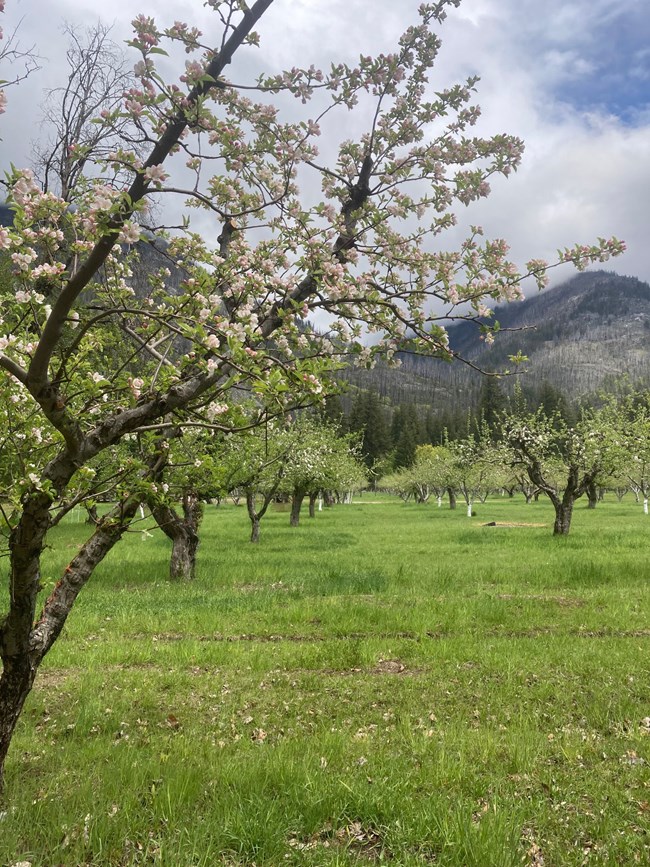
NPS
Seasons of Change
Much of what is documented about the landscape history comes from oral history, the descendent community, and the past and present work to maintain the orchard. Orchardist Laurie Thompson, returning volunteers, and the Buckner family share in an understanding of the orchard and its trees that can only come through personal connections to the landscape over time.
While there is no substitute for the depth of understanding that comes with experience, it is vital to be able to document and pass on this knowledge to the next stewards. In that way, the Buckner Orchard can continue to be cared for as the apple trees and the landscape continue to change.
The Cultural Landscape Report (CLR) is one of the tools that the National Park Services uses to help capture this record of the orchard's managment. The document incorporates history, existing conditions, evaluation and analysis, and treatment planning.
The CLR for the Buckner Homestead Historic District was published in June 2022. The report describes orchard care, as well as the relationship of the orchard to other resources and uses of the site. It identifies and documents the challenges, goals, and questions of landscape maintenance at a point in time, without necessarily providing all the answers.
The CLR also looks ahead to future conditions, which include increasing visitation, considerations for a hotter and drier future, and ways to make the orchard more resilient to disease. It will continue to be the basis for preservation treatment recommendations, with a goal of preserving character-defining characteristics and features of the cultural landscape, like the orchard.
Meanwhile, Thompson continues her work in the orchard through the changing seasons, alongside volunteers, partners, and a handful of other NPS staff. When the Buckner family lived here and developed the homestead and orchard, a community became connected to the landscape and its routines. It continues to be a place of personal stories, seasonal gatherings, and a backdrop to both work and life in the Stehekin Valley.
Learn More
Website Articles
Books
- Sargo, Irene, Harriet (Hobbie) Morehead, and Elizabeth (Bucky) Gans. The Stehekin We Remember. Wellspring Press and Printing, 2007. https://archive.org/details/stehekinwerememb0000iren/page/6/mode/2up

